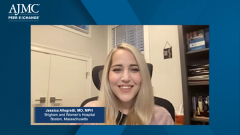
Payer Perspectives on Coverage Criteria for Clostridium Difficile Treatments
Payer participants break down how coverage criteria are determined for treatments for clostridium difficile infection.
Episodes in this series

Transcript:
Neil Minkoff, MD: I want to ask a question because my experience having gone from the provider side to the payer side has shown that there tends to be a disconnect at times between what the providers want to provide, specifically as it’s getting to be more cutting edge with newer guidelines and so on, and what the payers consider standard of care and are covering. I want to open up the conversations to Dr Abdallah and Dr Stephens about how they’re looking at treatment of, if not C difficile [Clostridioides difficile], recurrent C difficile and the kind of evidence they’re looking at, what their coverage policies are, and so on. Not necessarily the specifics around their exact coverage policies, but what their concepts are like. Dr Abdallah, do you want to start?
Karina Abdallah, PharmD: Sure. I’d be interested to hear what Dr Stephens has to say as well, but the jury is still out. Our health plan as well as a lot of health plans aren’t making any coverage decisions based on first-line fidaxomicin [Dificid] over vancomycin [Vancocin]. Either/or is still appropriate. For the recurrence, it depends on how much each health plan is willing to look into outcomes in terms of total cost of care, direct medical cost.
It’s really important first to align with the basics, like what the definitions are, what constitutes recurrence, how you’re looking at the data, and how you’re stratifying risk. That’s very important to have different buckets of not only your patient population, but to stratify risk ahead of when you start to see those costs go up and be really proactive.
Dr Stephens mentioned earlier proactively looking at your facilities, specifically long-term care facilities or any facilities that may have a higher set of recurrence, and working in a matrix setting to be able to address those cross-functionally and bring those in and some benchmarks and work together overall for the payer, health system, and any type of facility to look at whether we’re doing everything we can and identify the gaps. Are there any gaps on the payer side in terms of any delays to care due to any newly identified medications that may be a little bit higher cost up front? It’s important to ensure that the payer has that data that supports using a higher-cost treatment earlier on in the care.
The last thing as well that we mentioned is the prevention with Zinplava [bezlotoxumab]. That’s something that’s fairly newer with studies that showed its benefit. It’s important to ensure that payers are incorporating that into their formulary recommendations and looking at any real-world evidence that’s coming out post-market and tying those into overall total cost of care and any savings, really looking at anything that can get the total cost of care reduced. There are a lot of studies out right now that talk about the exact number of days of inpatient treatment. It’s like 18 vs 13 days based on whether it’s a recurrence or not, and your likelihood of reoccurrence based on what antibiotics you’ve had and what disease states you’ve had. We talked a little about IBD [inflammatory bowel disease] and those types of scenarios. It’s really important to have some risk stratification and work proactively with both health systems and facilities, and each payer can definitely put checks in place to do that.
Neil Minkoff, MD: That was tremendous. That was very thorough. I want to ask Dr Stephens: As you’re bringing this to your customers, your employers, etc., is this something that’s even on their radar screen? If not, how do you make determinations about the evidence you’re looking at to try to approve different therapies?
Kevin U. Stephens, Sr. MD, JD: That’s a very good question. Thank you very much. From the payer’s perspective, I need to remind everyone that there are pretty much 3 buckets that you have. One is the state Medicaid plan. Typically, in a state Medicaid plan, the state dictates what’s on the formulary, so we pretty much have to follow the state’s guidelines in terms of what’s on the formulary and that standard of treatment, more or less. Then you have Medicare. In Medicare, even in Medicare Advantage, we have LCDs [local coverage determinations] and have guidelines that CMS [Centers for Medicare & Medicaid Services] has done for Medicare and we pretty much stay with them. We have leeway. In many cases, as we said earlier, people over 65 have a bigger risk, so you see a shift in the curve to people who are in that group who are over 65.
Then you have everybody else in between, and that’s our commercial insurance, so to speak. That’s a tough space to be in, because in the commercial plan, the employer pays most of the premiums and it’s based on their expenditures. The more expenditures you have, the higher the premium, and the employers look at us and say, “What are you doing? We can’t afford them.” We have to make sure we keep a balance between the 2, because if the employers can’t afford it, then they cancel the plan. We want people not to be in the hospital and have good treatment, so that’s a balance that we have to do.
With that being said, we use the ACG [American College of Gastroenterology] guidelines, Milliman, and InterQual. We use an assorted variety of guidelines, including the IDSA [Infectious Diseases Society of America] guidelines. We pretty much get a policy based on the literature and the guidelines, and we have a panel of experts that convene. We convene very frequently, particularly during a change in dynamics like we have with C difficile, and then we change our guidelines based on the best literature and information.
But the biggest thing here, particularly for those in the audience, is that we have what we call a peer-to-peer option. The peer-to-peer option is when the reviewing medical director will talk directly to the treating provider. That’s your chance and time to talk to them and say, “Patient X has been in the hospital 5 times. This is the sixth episode. We have this, that, and the other, and this is what I want based on this.” Then the medical director has the discretion and latitude to make exceptions, because as we know, pretty much no disease process reads the book and follows the book by letter and verse. You don’t have just 1 problem. C difficile may be 1 of the problems, but you may have a whole myriad of other problems associated with it, including allergies. We have to go case by case.
The peer-to-peer process is a way for the providers to communicate directly with the reviewing medical director. You can make a case and have literature, case scenarios, all those types of things to find the best choice, because truly, our ultimate measure stick is the outcome. Of course, we look at patient satisfaction and those kinds of things, but 1 of the things that we look at is readmission rates and ED [emergency department] visits. When patients are going back to the emergency department and getting readmitted recurrently, then your total cost of care goes up. That’s why we try to make sure we institute the right guidance and protocols in that process.
Transcript edited for clarity.
Newsletter
Stay ahead of policy, cost, and value—subscribe to AJMC for expert insights at the intersection of clinical care and health economics.



































































